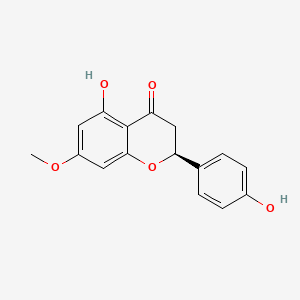| MeSH term | MeSH ID | Detail |
|---|---|---|
| Acne Vulgaris | D000152 | 35 associated lipids |
Sakuranetin
Sakuranetin is a lipid of Polyketides (PK) class. Sakuranetin is associated with abnormalities such as and Neurodegenerative Disorders. The involved functions are known as inhibitors, Drug Interactions, aldehyde reductase activity, Antiinflammatory Effect and antagonists. Sakuranetin often locates in Vacuole and Cell surface. The associated genes with Sakuranetin are PTPN1 gene.
Cross Reference
Introduction
To understand associated biological information of Sakuranetin, we collected biological information of abnormalities, associated pathways, cellular/molecular locations, biological functions, related genes/proteins, lipids and common seen animal/experimental models with organized paragraphs from literatures.
What diseases are associated with Sakuranetin?
Sakuranetin is suspected in Neurodegenerative Disorders and other diseases in descending order of the highest number of associated sentences.
Related references are mostly published in these journals:
| Disease | Cross reference | Weighted score | Related literature |
|---|
Possible diseases from mapped MeSH terms on references
We collected disease MeSH terms mapped to the references associated with Sakuranetin
PubChem Associated disorders and diseases
What pathways are associated with Sakuranetin
There are no associated biomedical information in the current reference collection.
PubChem Biomolecular Interactions and Pathways
Link to PubChem Biomolecular Interactions and PathwaysWhat cellular locations are associated with Sakuranetin?
Visualization in cellular structure
Associated locations are in red color. Not associated locations are in black.
Related references are published most in these journals:
| Location | Cross reference | Weighted score | Related literatures |
|---|
What functions are associated with Sakuranetin?
Related references are published most in these journals:
| Function | Cross reference | Weighted score | Related literatures |
|---|
What lipids are associated with Sakuranetin?
There are no associated biomedical information in the current reference collection.
What genes are associated with Sakuranetin?
Related references are published most in these journals:
| Gene | Cross reference | Weighted score | Related literatures |
|---|
What common seen animal models are associated with Sakuranetin?
There are no associated biomedical information in the current reference collection.
NCBI Entrez Crosslinks
All references with Sakuranetin
Download all related citations| Authors | Title | Published | Journal | PubMed Link |
|---|---|---|---|---|
| Hong L and Ying SH | Ethanol extract and isolated constituents from artemisia dracunculus inhibit esophageal squamous cell carcinoma and induce apoptotic cell death. | 2015 | Drug Res (Stuttg) | pmid:25076224 |
| Siciliano I et al. | Jasmonic Acid, Abscisic Acid, and Salicylic Acid Are Involved in the Phytoalexin Responses of Rice to Fusarium fujikuroi, a High Gibberellin Producer Pathogen. | 2015 | J. Agric. Food Chem. | pmid:26323788 |
| Taguchi L et al. | A flavanone from Baccharis retusa (Asteraceae) prevents elastase-induced emphysema in mice by regulating NF-κB, oxidative stress and metalloproteinases. | 2015 | Respir. Res. | pmid:26122092 |
| Hasegawa M et al. | Analysis on blast fungus-responsive characters of a flavonoid phytoalexin sakuranetin; accumulation in infected rice leaves, antifungal activity and detoxification by fungus. | 2014 | Molecules | pmid:25093982 |
| dos S Grecco S et al. | Structural crystalline characterization of sakuranetin--an antimicrobial flavanone from twigs of Baccharis retusa (Asteraceae). | 2014 | Molecules | pmid:24914898 |
| Lutz JA et al. | A nicotinic receptor-mediated anti-inflammatory effect of the flavonoid rhamnetin in BV2 microglia. | 2014 | Fitoterapia | pmid:24972350 |
| Toledo AC et al. | Flavonone treatment reverses airway inflammation and remodelling in an asthma murine model. | 2013 | Br. J. Pharmacol. | pmid:23170811 |
| Kim MJ et al. | Biosynthesis of bioactive O-methylated flavonoids in Escherichia coli. | 2013 | Appl. Microbiol. Biotechnol. | pmid:23771780 |
| Park HL et al. | Transcriptomic analysis of UV-treated rice leaves reveals UV-induced phytoalexin biosynthetic pathways and their regulatory networks in rice. | 2013 | Phytochemistry | pmid:24035516 |
| Yamane H | Biosynthesis of phytoalexins and regulatory mechanisms of it in rice. | 2013 | Biosci. Biotechnol. Biochem. | pmid:23748776 |
